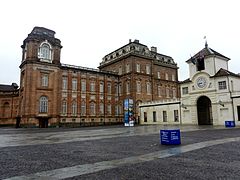Royal Palace of Venaria
| Palace of Venaria | |
|---|---|
| Reggia di Venaria Reale | |

View of the Palace.
|
|
|
Location within Piedmont
|
|
| General information | |
| Location | Venaria Reale, Metropolitan City of Turin, Italy |
| Coordinates | 45°08′10″N 7°37′35″E / 45.1362°N 7.62644°ECoordinates: 45°08′10″N 7°37′35″E / 45.1362°N 7.62644°E |
| Technical details | |
| Floor area | 80,000 m2 (861,112 ft2) |
| Website | |
| Official site of the Palace of Venaria | |
| Official name | Reggia di Venaria Reale - Residences of the Royal House of Savoy |
| Type | Cultural |
| Criteria | i, ii, vi, v |
| Designated | 1997 (21st session) |
| Reference no. | 823 |
| State Party | Italy |
| Region | Europe |
The Palace of Venaria (Italian: Reggia di Venaria Reale) is a former royal residence located in Venaria Reale, near Turin, in Piedmont, northern Italy. It is one of the Residences of the Royal House of Savoy, included in the UNESCO Heritage List in 1997.
The Palace was designed and built from 1675 by Amedeo di Castellamonte, commissioned by duke Charles Emmanuel II, who needed a base for his hunting expeditions in the heathy hill country north of Turin. The name itself derives from Latin, Venatio Regia meaning "Royal Hunt".
Charles Emmanuel was inspired by the example of the Castle of Mirafiori, built by Duke Charles Emmanuel I for his wife Catherine Michelle of Spain. Keen to leave a memorial of himself and his wife, Marie Jeanne of Savoy-Nemours, he bought the two small villages of Altessano Superiore and Altessano Inferiore from the Milanese-origin Birago family, who had created here a large complex of plants. The place was rechristened Venaria for his future function as hunting base.
The design was commissioned from architects Amedeo di Castellamonte and Michelangelo Garove. The plan of the annexed borough was to symbolize the collar symbol of the Supreme Order of the Most Holy Annunciation, a dynastic order created by the House of Savoy. In 1675 the borough and the palace were nearly completed, including the so-called Reggia di Diana (Royal Residence of Diana, the heart of the complex. Works however continued until the next century, as in 1693 French invasion troops are known to have destroyed some buildings and Duke (future King) Victor Amadeus II had the residence modified according to French canons.
...
Wikipedia

